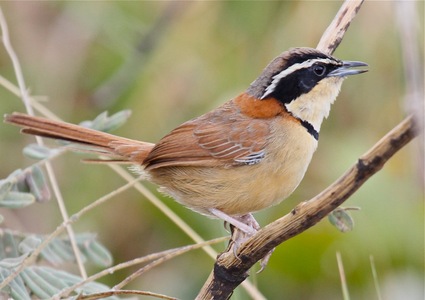
Melanopareia torquata
TAXONOMY
Synallaxis torquatus Wied, 1831, Campo Geral of inner Brazil =
campos on the Bahia-Minas Gerais border.
OTHER COMMON NAMES
French: Cordon-noir а col roux; German: Zimtbandvogel;
Spanish: Gallito de Collar.
PHYSICAL CHARACTERISTICS
5.7 in (14.5 cm); 0.56–0.81 oz (16–23 g). Tail is fairly long.
Above gray-brown (crown black in bitorquata), nuchal collar rufous,
concealed interscapular patch white. Brow white, sides of
head black. Throat buff, breast band black, rest of underparts
dark reddish brown, palest on lower belly.
DISTRIBUTION
M. t. torquata: Eastern Brazil. M. t. rufescens: Central Brazil
and northeastern-most Paraguay. M. t. bitorquata: Eastern
Bolivia.
HABITAT
Semi-arid scrub.
BEHAVIOR
Alone or in pairs. Runs on the ground and hops in low parts of
the vegetation.
FEEDING ECOLOGY AND DIET
Unknown.
REPRODUCTIVE BIOLOGY
Unknown.
CONSERVATION STATUS
Not threatened.
SIGNIFICANCE TO HUMANS
None known.
Photo Gallery of - Collared crescentchest




 Animalia Life
Animalia Life